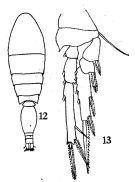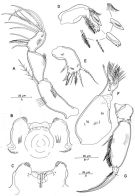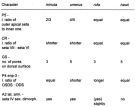|
|
 |
Fiche d'espèce de Copépode |
|
|
Cyclopoida ( Ordre ) |
|
|
|
Oncaeidae ( Famille ) |
|
|
|
Triconia ( Genre ) |
|
|
| |
Triconia minuta Giesbrecht, 1892 (F, M) | |
| | | | | | | Syn.: | Oncäa minuta Giesbrecht, 1892 (p.591, 603, 774, Descr.F, figs.F);
Oncaea minuta : Thompson & Scott, 1903 (p.239); Esterly, 1905 (p.217, figs.F); Farran, 1908 b (p.92, Rem.); A. Scott, 1909 (p.242, Rem.); Pesta, 1912 a (p.58); non Sars, 1918 (p.217, figs.F, Rem.: p.218); Wilson, 1932 a (p.352, figs.F); Rose, 1933 a (p.298, figs.F); Wilson, 1942 a (p.198, fig.F); Bainbridge, 1972 (p.61, Appendix Table II, vertical distribution %); Razouls, 1972 (p.95, Annexe: p.116, figs.F); Chen & al., 1974 (p.43, figs.F); no Razouls, 1974 b (p.240, figs.F); Shuvalov, 1976 (in Kos, 1976, Vol. II, figs.F, Rem.); Dawson & Knatz, 1980 (p.9, figs.F); Björnberg & al., 1981 (p.668, figs.F); Malt, 1983 a (p.6, fig.F, Rem.); Malt & al., 1989 (p.959, Rem.M); Böttger-Schnack, 1990 (p.869, tab.III); Ohtsuka & al., 1996 a (p.91); Chihara & Murano, 1997 (p.981, Pl.225: F); Boxshall, 1998 (p.226); Conway & al., 2003 (p.222, figs.F, Rem.);
Ref. compl.: Wilson, 1932 (p.50); Massuti Alzamora, 1942 (p.103, Rem.); Sewell, 1948 (p.393, 461, 487); C.B. Wilson, 1950 (p.272); Grice, 1956 (p.68); Fagetti, 1962 (p.43); Gaudy, 1963 (p.32, Rem.); Björnberg, 1963 (p.81, Rem.); Unterüberbacher, 1964 (p.34, Rem.: ?); Shmeleva, 1965 b (p.1350, lengths-volume -weight relation); Furuhashi, 1966 a (p.295, vertical distribution in Kuroshio region, Table 9);Mazza, 1966 (p.73); Pavlova, 1966 (p.45); Delalo, 1968 (p.139, Rem.: ?); Tsalkina, 1970 (p.507); Kovalev, 1970 (p.91, Tableau 1, 2, fig., egg production); Deevey, 1971 (p.224); Salah, 1971 (p.320); Apostolopoulou, 1972 (p.329, 379); Zalkina, 1977 (p.339, tab.1); Dessier, 1979 (p.207); Vaissière & Séguin, 1980 (p.23, tab.1); Vives, 1982 (p.295); Kovalev & Shmeleva, 1982 (p.85); Tremblay & Anderson, 1984 (p.7, Rem.); Greze & al., 1985 (p.8); Jansa, 1985 (p.108, Tabl.I, II, III, IV); Brinton & al., 1986 (p.228, Table 1); Böttger-Schnack & al., 1989 (p.1089); Kosobokova, 1989 (p.26); Böttger-Schnack, 1992 (p.304); 1994 (p.277); Kosobokova & al., 1995 (p.194); Shih & Young, 1995 (p.77); Böttger-Schnack, 1995 (p.92); 1997 (p.409); Kosobokova & al., 1998 (tab.2); Suarez-Morales & Gasca, 1998 a (p.112); Noda & al., 1998 (p.55, Table 3, occurrence); Siokou-Frangou, 1999 (p.479); Kosobokova & Hirche, 2000 (p.2029, tab.2); El-Sherif & Aboul Ezz, 2000 (p.61, Table 3: occurrence); Daly Yahia & al., 2004 (p.366, fig.4); Lan & al., 2004 (p.332, tab.1); Prusova & Smith, 2005 (p.76, 78); Khelifi-Touhami & al., 2007 (p.327, Table 1); Zakaria, 2007 (p.238, Table 2, spatial distribution); Hwang & al., 2007 (p.25); C.-Y. Lee & al., 2009 (p.151, Tab.2); Lidvanov & al., 2010 (p.356, Table 3); Fazeli & al., 2010 (p.153, Table 1); Moscatello & al., 2011 (p.80, Table 4); Kâ & Hwang, 2011 (p.155, Table 3: occurrence %); Hsiao & al., 2011 (p.317, Table 2, indicator of seasonal change); Selifonova, 2011 a (p.77, Table 1, alien species in Black Sea); Uysal & Shmeleva, 2012 (p.909, Table I); DiBacco & al., 2012 (p.483, Table S1, ballast water transport); Tseng & al., 2013 (p.507, seasonal abundance); Lidvanov & al., 2013 (p.290, Table 2, % composition); Pansera & al., 2014 (p.221, Table 2, abundance); Zaafa & al., 2014 (p.67, Table I, occurrence);
? Oncaea sp.A: Razouls, 1974 (p.241, Fig.16) | | | | Ref.: | | | Böttger-Schnack, 1999 (p.43, 70, Redescr.F,M, figs.F,M, Rem.); Di Capua & Boxshall, 2008 (p.1410, figs.F, table 1); Vives & Shmeleva, 2010 (p.344, figs.F,M, Rem.); Böttger-Schnack & Machida, 2011 (p.111, Table 1, 2, fig.2, 3, DNA sequences, phylogeny) |  issued from : Q.-c Chen & S.-z. Zhang & C.-s. Zhu in Studia Marina Sinica, 1974, 9. [Pl.7, Figs.12-13]. Female (from China Seas): 12, habitus (dorsal); 13, P4.
|
 issued from : R. Böttger-Schnack in Mitt. hamb. zool. Mus. Inst., 1999, 96 [p.72, Fig.14]. Female (from Red Sea): A, habitus (dorsal); B, idem (lateral right side); C, urosome (dorsal); D, idem (lateral left side); E, A1; F, caudal ramus (dorsal); G, P5 (dorsal). Nota: Proportional lengths (%) of urosomites and caudal rami 10.2:54.9:6.4:5.7:11.0:11.7. A1 6-segmented, relative lengths (%) of segments of A1 measured along posterior non-setigerous margin 13.2:21.3:39.4:11.7:5.9:8.5. Caudal ramus about 1.7 times as long as wide. Anal somite 1.2 times wider than long, about same length as caudal rami.
|
 issued from : R. Böttger-Schnack in Mitt. hamb. zool. Mus. Inst., 1999, 96 [p.73, Fig.15]. Female: A, A2 (anterior); B, labrum (anterior); C, idem (posterior); D, Md (showing individual elements); E, Mx1; F, Mx2; G, Mxp.
|
 issued from : R. Böttger-Schnack in Mitt. hamb. zool. Mus. Inst., 1999, 96 [p.74, Fig.16]. Female: A, P1 (posterior); B, P2 (anterior); C, P3 (anterior); D, P4 (anterior). Nota: The length of the outer subdistal spine on P4 endop-3 was slightly smaller than the outer distal spine in the Red Sea specimens, whereas in specimens from the Gulf of Naples both spines are equal in length (Giesbrecht;, 1892, Pl.47, Fig.59). Thes differences, however, can be regarded as variation between specimens (as found for instance also in T. dentipes.
|
 issued from : R. Böttger-Schnack in Mitt. hamb. zool. Mus. Inst., 1999, 96 [p.76, Fig.17]. Male (from Red Sea): A, habitus (dorsal); B, A1; C, Mxp (anterior); D, urosome (dorsal); E, idem (ventral); F, idem (lateral left side); G, A2 (distal endopod segment). Nota: A1 4-segmented, relative lengths (%) of segments of A1 measured along posterior non-setigerous margin 8.8:23.5:39.4:28.2. P6 represented by posterolateral flap closing off genital aperture on either side, covered by pattern of spinules.
|
 issued from : R. Böttger-Schnack in Mitt. hamb. zool. Mus. Inst., 1999, 96 [p.77, Table 3]. Morphological characters separating males of Triconia minuta, T. umerus, T.rufa and T. hawii. ODS = outer distal spine; OSDS = outer subdistal spine; endp-3 = 3th endopod segment; l = length; sex dimorph. = sexually dimorphic; GS = genital somite; P4, P5 = thoracopods 4, 5; A2 = antenna; CR = caudal rami; lat. arm = lateral armature.
|
 issued from : G.O. Sars in An Account of the Crustacea o Norway, 1918, VI. [Pl. CXVIII, 2]. As Oncaea minuta.
|
 Issued from : W. Giesbrecht in Systematik und Faunistik der Pelagischen Copepoden des Golfes von Neapel und der angrenzenden Meeres-Abschnitte. – Fauna Flora Golf. Neapel, 1892, 19 , Atlas von 54 Tafeln. [Taf.47, Figs.3, 26]. Female: 3, habitus (lateral); 26, same (dorsal).
|
 Issued from : W. Giesbrecht in Systematik und Faunistik der Pelagischen Copepoden des Golfes von Neapel und der angrenzenden Meeres-Abschnitte. – Fauna Flora Golf. Neapel, 1892, 19 , Atlas von 54 Tafeln. [Taf.47, Fig.6]; Female: 6, urosome (dorsal).
|
 Issued from : W. Giesbrecht in Systematik und Faunistik der Pelagischen Copepoden des Golfes von Neapel und der angrenzenden Meeres-Abschnitte. – Fauna Flora Golf. Neapel, 1892, 19 , Atlas von 54 Tafeln. [Taf.47, Figs.46, 59]. Female: 46, Mxp; 59, P4.
| | | | | Ref. compl.: | | | Böttger-Schnack & al., 2001 (p.1029, tab.1, 2); Hsieh & al., 2004 (p.398, tab.1); Krsinic & Grbec, 2002 (p.127, tab.1); Nishibe & Ikeda, 2004 (p.931, Tab. 2, 5); Böttger-Schnack & al., 2004 (p.1130, tab.1, Rem.); Böttger-Schnack, 2004 (p.220: tab.2, Rem.); Nishibe & al., 2009 (p.491, Table 1: seasonal abundance); Böttger-Schnack & Schnack, 2009 (p.131, Table 3, 4); Mazzocchi & Di Capua, 2010 (p.429); Dvoretsky & Dvoretsky, 2010 (p.991, Table 2); Salah S. & al., 2012 (p.155, Tableau 1); Shiganova & al., 2012 (p.61, Table 4); Gubanova & al., 2013 (in press, p.4, Table2); in CalCOFI regional list (MDO, Nov. 2013; M. Ohman, comm. pers.); Mazzocchi & al., 2014 (p.64, Table 5, abundance); Fierro Gonzalvez, 2014 (p.1, Tab. 3, 5, occurrence, abundance) ; Zakaria & al., 2016 (p.1, Table 1); Benedetti & al., 2016 (p.159, Table I, fig.1, functional characters); El Arraj & al., 2017 (p.272, table 2); Benedetti & al., 2018 (p.1, Fig.2: ecological functional group); Chaouadi & Hafferssas, 2018 (p.913, Table II: occurrence). | | | | NZ: | 20 + 1 douteuse | | |
|
Carte de distribution de Triconia minuta par zones géographiques
|
| | | | | | | | | | | | | | |  issued from : A.V. Kovalev in Gidrobiol. Zh., 1970,
6 (5). [p.92, Table 1]. As Oncaea minuta. issued from : A.V. Kovalev in Gidrobiol. Zh., 1970,
6 (5). [p.92, Table 1]. As Oncaea minuta.
Relation between the body length of females and number of eggs.
A: species; B: number of females; C: length of females in mm; D: number of eggs in relation to the lengths of females. |
| | | | Loc: | | | Namibia (?), Congo, off Lagos, off Morocco-Mauritania, Cap Ghir, off Madeira Is., Argentina, S Brazil, Venezuela, Florida (Alligator Harbor), Sargasso Sea, off Bermuda, Chesapeake Bay, off S Newfoundland, Greenland, off W Ireland, Norway, North Sea, Ibero-moroccan Bay, off W Tangier, Medit. (M'Diq, Alboran Sea, Habibas Is., Sidi Fredj coast, Gulf of Annaba, Baleares, Banyuls, Ligurian Sea, Tyrrhenian Sea, Lake Faro (Sicily), Strait of Messina, N & S Adriatic Sea, Vlora Bay, Aegean Sea, Black Sea, Lebanon Basin, W Egyptian coast, Alexandria), ? Suez Canal, Sharm El-Sheikh, G. of Aqaba, Red Sea (N-S), Gulf of Oman, G. of Aden, Arabian Sea, NW & E Indian, Bay of Bengal, Indonesia-Malaysia, Sulu Sea, Philippines, China Seas (East China Sea, South China Sea), Taiwan Strait, Taiwan (S, W, NW, NE), Japan (Kuchinoerabu Is., Tosa Bay, Kuroshio & Oyashio regions), Bering Sea, Laptev Sea, Barents Sea, Canadian abyssal plain, Aleutian Is., G. of Alaska, California (San Pedro Bay), Gulf of California, W Mexico, G. of Panama, off Galapagos, off Hawaii, Peru, Fiji Is., Peru, off Chile | | | | N: | 109 ? | | | | Lg.: | | | (24) F: 0,76-0,68; M: 0,62; (45) F: 0,5-0,45; (46) F: 0,58-0,56; (109) F: 0,56-0,5; (133) F: 0,46; (142) F: 0,5-0,46; (237*) F: 0.45; (432) F: 0,62-0,45; (788) F: 0,56-0,5; M: 0,41-0,39; (810) F: 0,56-0,50; M: 0,41-0,39; (1014) F: 0,474; (1101) F: 0,41-0,55; {F: 0,41-0,76; M: 0,39-0,62}
*: probably noted 4.5 mm (lapsus calami) | | | | Rem.: | méso-bathypélagique.
Esterly (1905, p.217) suggère que le mâle figuré par Aurivillius (1899, p.29, figs.1-3) pourrait appartenir à cette espèce, ce qui ne peut être confirmé par Böttger-Schnack (1999).
Pour Böttger-Schnack (1999, p.78) la signalisation de cette espèce dans les divers océans est sujet à caution, faute de figures ou de descriptions suffisantes pour certifier son identification.
Voir aussi les remarques en anglais | | | Dernière mise à jour : 25/10/2022 | |
|
|
 Toute utilisation de ce site pour une publication sera mentionnée avec la référence suivante : Toute utilisation de ce site pour une publication sera mentionnée avec la référence suivante :
Razouls C., Desreumaux N., Kouwenberg J. et de Bovée F., 2005-2025. - Biodiversité des Copépodes planctoniques marins (morphologie, répartition géographique et données biologiques). Sorbonne Université, CNRS. Disponible sur http://copepodes.obs-banyuls.fr [Accédé le 25 décembre 2025] © copyright 2005-2025 Sorbonne Université, CNRS
|
|
 |
 |













